Fresh-squeezed Facts: A Parent’s Guide to Juice (FN1644, Revised March 2018)
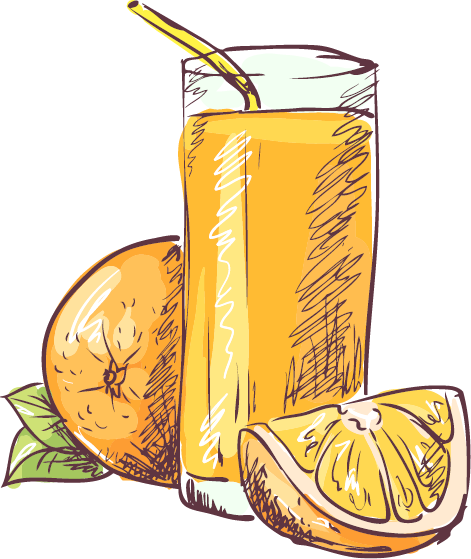
iStock image
A balanced diet includes a variety of foods. Like foods, most beverages can fit into a healthful diet. The problem is, many children consume too much juice, often in place of milk, water, fruits or vegetables. While most 100 percent fruit juices contain vitamin C and some minerals, they often lack the fiber that whole fruit contains.
Children who drink large amounts of juice consume vitamins and minerals, but they get more calories from juice than from mashed or chopped whole fruit. Children who consume too much juice may not be hungry at mealtime and may miss out on other important nutrients their bodies need to grow.
For dental health, do not allow your child to carry a “sippy cup” or box of juice with him or her throughout the day. Do not put juice in a bottle because the natural sugars in juice can promote tooth decay. Healthy baby teeth are vital to a healthy mouth lifelong.
In addition, some types of juice, such as apple and pear, contain high amounts of sorbitol, a nondigestible sugar alcohol, which may cause stomach upset or diarrhea in some children. For these reasons, most health-care professionals recommend that parents limit the amount of juice their children drink.
Too much juice can promote weight gain, tooth decay and stomach cramps and/or gas.
When can you begin providing juice to infants?
According to the Academy of Nutrition and Dietetics and the American Academy of Pediatrics, parents or caregivers should wait to introduce juice until the infants reach the age of 12 months and are able to drink from a cup.
How can you limit the amount of juice your child drinks?
Try these tips:
- Offer juices less often or dilute them with water.*
- Have water available in place of juice in a cup.
- Serve juicy fruits as snacks instead of juice. Be sure to mash or cut fruit appropriately to avoid choking hazards.
- Serve milk with meals.
* Note: Child-care providers on federal food programs must provide 100 percent (undiluted) juice.
How much juice should you allow?
As shown in the table below, juice recommendations vary based on age, according to the American Academy of Pediatrics (AAP).
Maximum Juice recommendations* for Children
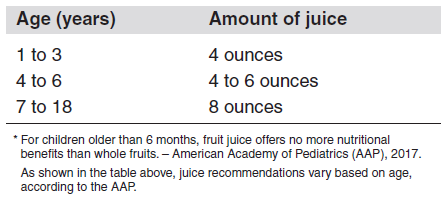
If you choose to provide juice to your infant, wait until 12 months, be sure your infant can drink from a cup and offer juice in limited amounts.
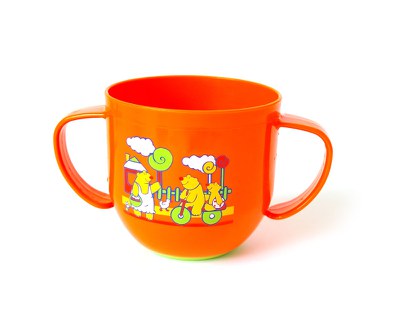
Bigstock photo
Are all fruit beverages created equal?
Definitely not! Manufacturers of juice beverages are required to list the percentage of juice on the label of their product. Look for juices with labels that say “100 percent fruit juice.” Products labeled “fruit or juice drink,” “juice beverage” or “juice cocktail” may be mostly sugar water and only 5 to 10 percent juice. Grape and orange soda, and other fruit-flavored soft drinks, contain no juice.
Not all 100 percent fruit juices are equal, either. Unless fortified, grape and apple juice contain little or no vitamin C and are naturally higher in sugar than most other fruit juices. On the other hand, orange juice is naturally low in sugar and high in vitamin C and potassium.
However, keep in mind that some infants may not tolerate citrus juices well. Thus, wait until a child is 1 year old to offer juices such as orange or grapefruit. Try a noncitrus vitamin C-fortified juice instead.
Juice safety
Q: I read somewhere that people have been sickened or died from drinking apple juice. How can I be sure the juice I buy is safe?
A: Unpasteurized juice has caused foodborne illness. When fruit is squeezed to make juice, any bacteria on the outside of the fruit may get into the juice. Juice, like milk, should be pasteurized to kill any harmful bacteria that may be present. The symptoms of foodborne illness can include vomiting, diarrhea, abdominal pain, fever and headache. See a health professional if you or your child experience these symptoms.
Unpasteurized juice might be found at farmers markets or in the refrigerated sections of grocery stores. Pasteurized juice includes frozen concentrates and juices in shelf-stable containers such as juice boxes, bottles or cans. However, sometimes pasteurized juices are sold at refrigerator temperature.
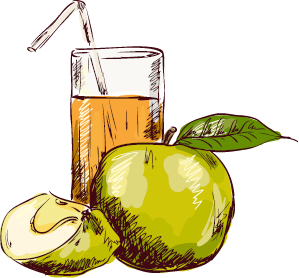
iStock image
To make sure your juice is safe, shop smart and look for any warning labels on juice containers.
All unpasteurized juice products are required to carry a warning label:
WARNING: This product has not been pasteurized and therefore may contain harmful bacteria that can cause serious illness in children, the elderly, and persons with weakened immune systems.
Note: If you squeeze your own apple juice at home, be sure to heat the juice to 160 F and then refrigerate. This heat treatment will kill illness-causing bacteria.
What's in a Serving* of 100 Percent Fruit Juice?
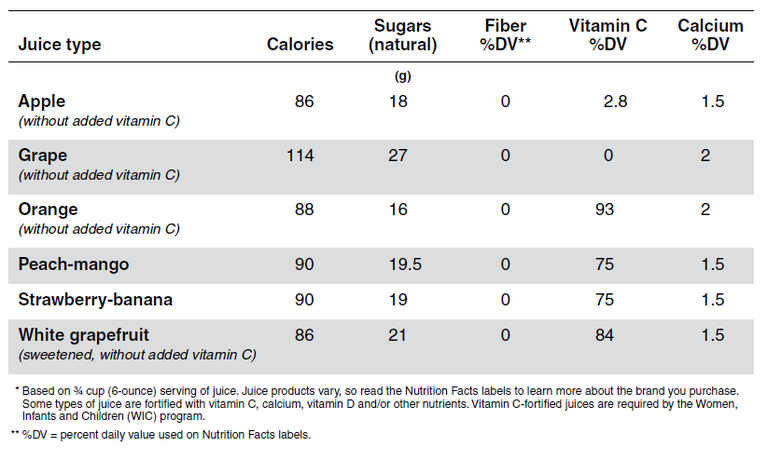
References:
Academy of Nutrition and Dietetics. (2018). “Nutrition Information about Beverages.” Retrieved Mar. 8, 2018.
American Academy of Pediatrics Policy Statement. (2017). Fruit Juice in Infants, Children, and Adolescents: Current Recommendations. 139(6). Retrieved Feb. 27, 2018.
American Academy of Pediatrics (2012). “Fruit Juice and Your Child’s Diet.” Retrieved Feb. 12, 2013.
U.S. Food and Drug Administration. (2011) “Safe Eats – Fruits, Veggies & Juices.” Retrieved Feb. 12, 2013.
U.S. Food and Drug Administration. (2013). “Talking About Juice Safety: What You Need to Know.” Retrieved Feb. 12, 2013.

Revised March 2018

